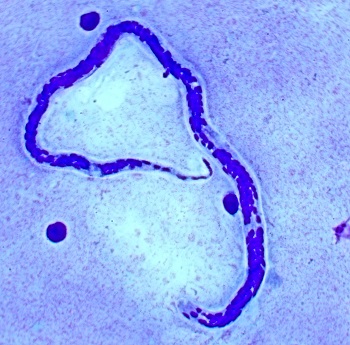Loa loa - Laboratory diagnosis, Treatment, Prevention, Control
Laboratory diagnosis of Loa loa
The laboratory diagnosis of Loa loa is primarily done by demonstration and identification of microfilariae in the peripheral blood.
Sample
peripheral blood (collected during the day - taken between 10 am and 2 pm)
biopsy (subcutaneous tissue, cornea)
urine
sputum
saliva
Microscopy
Microscopy is done for diagnosis of Loa loa infection.
The peripheral blood is collected during the time when a large number of microfilariae are found in the peripheral blood i.e. during the day. By finger prick method, 2 to 3 drops of peripheral blood are collected and viewed under a microscope.
Microscopy is done by:
Direct Wet Mount
Stained thick blood film smear
Concentration of blood

Loa loa microfilariae under microscope after Giemsa stain of blood smear (Source: Wikipedia)
Direct Wet Mount
Direct wet mount microscopy of blood for laboratory diagnosis of Loa loa involves the collection of 2 to 3 drops of peripheral blood on a clean glass slide and examination under a microscope.
The presence of live Loa loa microfilariae confirms the diagnosis.
Stained thick blood film smear
As the name suggests, stained thick blood film smear involves thick blood smear stained with Giemsa (stains very poorly), iron-hematoxylin, or eosin. The presence of a sheath with a row of nuclei from the head to the tail of microfilaria confirms infection of the patient by Loa loa.
Concentration of blood
If the number of Loa loa microfilariae in the blood is less, various methods are followed for the concentration of blood. Such methods include:
Knott’s method of concentration by sedimentations (centrifugation of the blood sample lyzed in 2% formalin)
membrane filtration by Millipore membrane filter or nucleophore membrane filter
* membrane filter methods are sensitive methods
Serological test
In recent years, serologic diagnostics tests that are highly specific to Loa loa have been developed. Antigen detection using an immunoassay for circulating filarial antigens is followed as microfilaremia can be low and variable.
A major disadvantage of antibody detection tests is cross-reactivity filaria and other parasitic worms (helminths) and their inability to distinguish between past and ongoing infections.
Quick luciferase immunoprecipitation assay (QLIPS) has a high sensitivity (97%) and specificity (100%) in comparison to LISXP-1 ELISA test which has a poor sensitivity (55%).
Treatment of Loa loa
Loa loa infection is treated by oral administration of Ivermectin and DEC (diethylcarbamazine) in high doses. The drug kills the microfilariae but not all adult worms. The adult parasites can be removed via surgery.
Prevention, Control of Loa loa
The prevention and control of Loa loa infection are based on
successful treatment of infected individuals
reduction of transmission by controlling mosquito population especially around housing by eliminating breeding places, spraying oils and chemicals in breeding sites
using mosquito nets while sleeping, and netted windows in endemic areas
use of biological control agents such as bacteria
wearing protective clothing
use of mosquito repellants
chemoprophylaxis